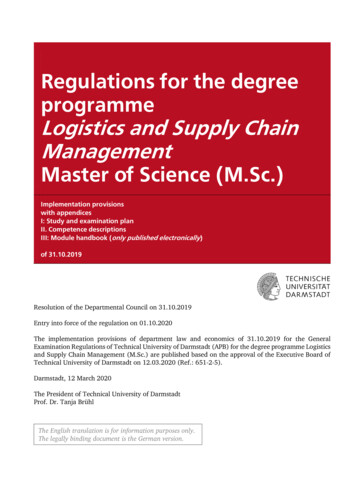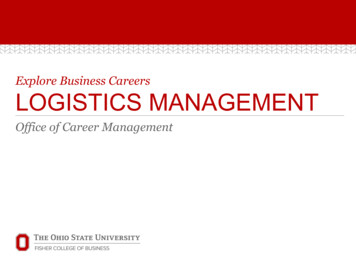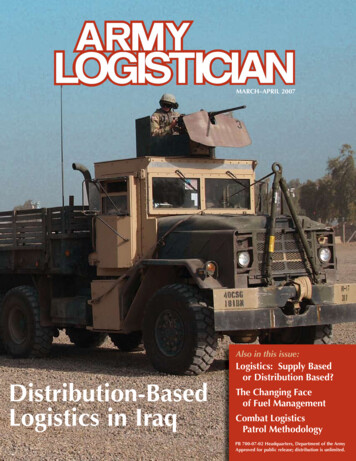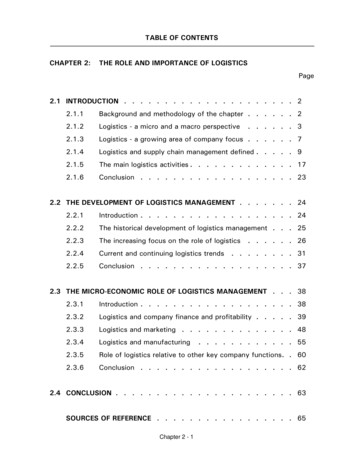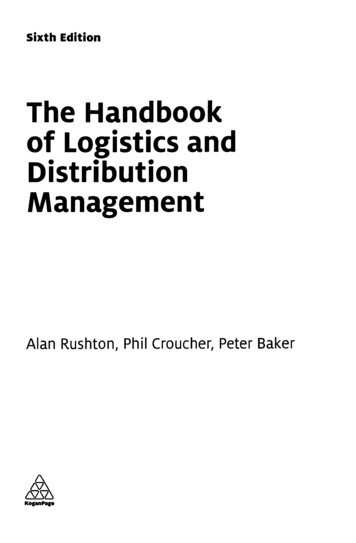
Transcription
The Role of Logistics Service Providers in the Logistics Firms’ Supply ChainMaster Thesis within Business AdministrationAuthor: Ojo Iseghohime AjakaiyeTutors: Prof. Susanne Hertz and Hamid JafariJonkoping, June, 2012
AcknowledgementI am grateful to the Almighty Father for making it possible for me to achieve my aimat Jonkoping University.My sincere gratitude goes to my supervisors- professor Susanne Hertz and HamidJafari for their kindness, guidance and support throughout my period at the school.Finally, I thank my family, the respondents, friends and every other person that contributed towards my success at the University.Ojo Iseghohime AjakaiyeJonkoping International Business SchoolJune, 2012i
Master Thesis in International Logistics and Supply Chain ManagementTitle: The Role of Logistics Service Providers in the Logistics Firms’ Supply ChainAuthor: Ojo Iseghohime AjakaiyeTutors: Prof. Susanne Hertz and Hamid JafariDate: June, 2012Subject terms: Role, Third-party logistics service providers, Logistics firms’ supplychains, Network, Carriers and Logistics intermediary.AbstractCompetition amongst companies in the global market has resulted in increasedproduction of goods and services. Enterprises are now faced with the challenges ofshipments of raw materials, spare parts from vendors, and the finished goods toconsumers. Logistics companies are springing up to tackle transportation and otherlogistics problems. There are various logistics companies such as logistics intermediaries, carriers and third party logistics service providers in the market which are inone way or the other competing and at the same time cooperating within the supply chain in order to fulfill their assignments to their customers. Third party logisticsservice providers are experiencing rapid growth because of the advanced demandof services such as the desire to reduce lead time, inventory management, outsourcing, and a host of other functions. Not much has been written on the logisticsfirms. Besides, most studies on logistics firms and the third-party logistics providersfocus more on such aspects like their skills, services, and their relationships withtheir customers.The purpose of this thesis is to analyze the logistics service providers’ roles withinthe logistics firms’ supply chain by identifying how the expected roles are performed. In the frame of reference, the author searched several books and articlesthat are relevant within the scope of the thesis topic. Both qualitative and explorative data collection methods are used in the thesis and these involve conducting interviews, and reading the accounts of other people concerning the thesis topic.The conclusion shows that logistics service providers are able to perform their rolesthrough vertical and horizontal cooperation with other firms and with other logisticsfirms respectively. Besides, logistics firms do live up to their roles. Carriers and thelogistics intermediary now perform more roles than what people think they do, because networks connection and the urge to remain competitive make them to takeup value-added services. Third-party logistics service providers add values for theircustomers through their value-added services in various ways such as time andplace utility including tracking and tracing the goods to ensure that they are delivered.ii
AbbreviationsARA: Actors, Resource and ActivityCRM: Customer Relationship ManagementDHL: (DHL is derived from the first letter of the surnames of each of the threefounders: Dalsey Hillblom Lynn).DSC: Dry Storage CorporationFCL: Full Container LoadIT: Information TechnologyJIT: Just-in-timeKNPS: Kuehne Nagel Production SystemLCL: Less Container LoadLSI: Logistics Service IntermediariesLSP: Logistics Service ProviderLTL: Less-than-TruckloadR&S: Rohde and LiesenfeldPoD: Proof of deliverySDR: Svensk DirektreklamTNT: Thomas Nationwide TransportTPL: Third Party LogisticsUPS: United Parcel Service3PL: Third-party Logisticsiii
Table of Contents1 INTRODUCTION . 71.11.21.31.4Background .7Problem discussion .7Purpose .8Research questions .82 FRAME OF REFERENCE . 5.22.5.32.5.42.62.7What is role? . 10Third party logistics and the supply chain . 10Logistics firms’ Supply Chain . 12The growth and types of logistics service providers . 12Third party logistics firm compared to other logistics firms . 15Selecting a third party logistics service provider . 16Network of third party logistics service providers . 17The role of third party logistics service providers in the supply20Actors, Resources and Activities (ARA) model / networks . 21Activity links An . 21Resource ties . 21Actor bonds . 21Network . 22Innovation and Value-added Services. 24Summary. 253 METHODOLOGY . 273.13.23.33.43.53.63.73.8The meaning of research . 27Research Approach . 27Research Design. 28Primary data . 28Secondary Data. 29Literatures Review . 29Method of sampling . 30Validity and Reliability . 314 EMPIRICAL STUDY . 2Geodis Wilson. 32Brief history of the Company . 32Company operations . 33Value added services . 33Bring Group . 33Brief history of the Company . 33Company operations . 34Value-added services. 35United Parcel Service (UPS) . 36Brief history of the company . 36Company operations . 36iv
.6.24.6.34.74.7.14.7.2Value-added services. 37JETPAK GROUP . 37Brief history of the company . 37Company operations . 37Value-added services. 38KUEHNE NAGEL . 38Brief history of the company . 38Company operations . 38Value-added services. 40Unus International Company . 40Brief history of the Company . 40Company Operations. 41Value-added services. 41Svensk Direktreklam (SDR) . 42Brief history of the company . 42Company operations . 425 ANALYSIS . 435.15.25.35.45.5Classification of logistics companies . 43Selecting a third party logistics service provider . 43Network . 44Evolving roles . 46Adding value for customers. 476 CONCLUSION . 49List of references . 51v
FiguresFigure 2.1 Problem-solving abilities-TPL provider positions (Hertz & Alfredsson 2003,P. 141) 14Figure 2.2 Industrial supply chains and the logistics firms’ network of interaction 18Figure 2.3 ARA model (Hakansson & Johansson, 1992, p. 28) .22Figure 2.4 Showing business network as connected relationships (Dahlin & Thilenius2006, p. 3) 22Figure 2.5 Connected relations for firms in a dyadic relationship (Holmen & Pedersen 2001, P. 5) .24Figure 5.1 Industrial supply chains and the logistics firm’s network of interaction.46TablesTable 2.1 Capabilities of logistics firms in different networks (Cui &Hertz, 2011).20Table 3.1 Schedule of interview .31Table 5.2 Logistics firms .46vi
1INTRODUCTIONThis is the introductory chapter of this thesis, and it contains the background, problem discussion, the purpose, research questions and delimitation.1.1BackgroundOpportunities are created for all enterprises because of new markets and sources ofsupplies that are opened up. In spite of these opportunities in the global markets, industries are also faced with the challenges of shipments of raw materials, spare partsfrom vendors, and finished goods to customers. This therefore implies that the distance factor has imposed serious challenges on logistics and supply chain managers.They think of how best to obtain high levels of efficiency, reliability, and reduced cycletimes (Coyle, Bardi & Langley, 2003).The logistics industry is a vital industry experiencing growth as a result of factors suchas deregulation, mergers and alliances, including growth in logistics firms (Cui &Hertz,2011). There has been a rapid growth in Third Party Logistics service providers owningto the emergence of advanced demand of logistics services which includes the urge toshorten lead time, customers demand and outsourcing. Various firms belonging toother fields have now penetrated into the logistics market to compete with the firmswhose traditional roles have been transportation and warehousing (Hertz &Alfredsson, 2003). The traditional ways of developing and structuring logistics and thesupply chain are now obsolete to sustaining emerging organizations because of globalization, increasing competition, the desire to enhance reduced order cycle time as wellas inventory levels (Bolumole, 2001). Coyle et al. (2003) claim that the term logisticsbecame universally recognized over twenty years ago, and described logistics as a series of integrated enterprises that have to share information, coordinate physical execution to make sure there is a smooth flow of goods, services. Logistics is in charge ofthe movement and storage of materials as they are moving through the supply chainchannels (Waters, 2003).The success of a business emanates from superior performance of a product offered ata leveraged price, having extraordinary services and convincing values (Hughes, Ralf &Michels, 1999). Form utility, place utility, time utility, and possession utility are thetypes of economic utility that basically add value to a product or service (Coyle et al.,2003). Value is created only when goods reach the market and are sold to those thatdemanded them (Toney, 2004). Logistics will be seen as part of management in thetwenty-first century, and can be categorized into four groups – business logistics, military logistics, event logistics, and service logistics (Coyle et al., 2003).1.2Problem discussionIn the past, organizations were mainly interested in the production perspective of materials while less attention was given to their movement (Tseng, Yue, & Taylor, 2005;Waters, 2003). Although managers realized the need for the logistics perspective ofmaterials, they thought it to be a mere technical issue that deserved less attention.Management then regarded logistics as an unavoidable cost usually associated with7
businesses (Waters, 2003). Transportation of finished goods began to receive attentionin the 1920s. Also, until 1962, logistics was described as the most neglected but promising perspective of a business. The surveys carried out in the 1970s and 80s suggestedthat logistics was expensive and accounted for 15-20 percent of revenue; and that organizations would be able to make significant savings if appropriate attention was given to it (Waters, 2003). According to Waters (2003) logistics is essential for every organization including those that supply intangible services; it has a strategic role to play.For a firm to achieve its objective a greater cooperation is needed amongst the variousvalue-added functions. The United States and European firms, for instance, are facing alot of competitive problems because of their failure to manage their firms as unifiedvalue-added systems. When a firm sticks to its traditional inward-looking measures only, it could result in service-gaps and thereby pave the way for competitors to enter into the market and possibly capture some of the customers. It is of great importance formanagers to realize that a firm’s value-adding ability emanates from the entire flowsand processes of the firm. Furthermore, a firm through its marketing research has tosource information regarding its customers’ requirements and how best to add valuesthat can help their customers to become successful in their businesses. Value-addedactivities of manufacturing, logistics and purchasing are responsible for the provisionof form, place, time and possession utilities (Fawcett & Fawcett, 1995).Despite the importance and the rapid growth of the logistics industry, much has notbeen written on logistics firms per se (Cui &Hertz, 2011). Most studies on logisticsfirms and logistics service providers centered on their services, skills, and the extent oftheir integration and relationships with customers (Cui and Hertz, 2011; Andersson,1997). Besides, Fabbe-Costes, Jahre and Roussat (2008) state that studies on third party logistics concentrate more on firm and shipper-provider relationship. The authorobserved that not much has been done on how the third party logistics provider operates within the logistics firm supply chain. It is not only the gap in this aspect that is amotivating factor to the author, but his interest in knowing the role of the third partyservice providers in the logistics firms supply chain is another factor.1.3PurposeThe purpose of this thesis is to analyze the logistics service providers’ roles within thelogistics firms’ supply chain by identifying how the purported roles are performed.1.4Research questionsThree research questions are formulated in a bid to carry out this study:Through which network can the third party logistics service providers perform theirexpected roles?How do the logistics firms fulfill their expected roles?How do the third-party logistics service providers add value for their customersthrough value–added services?8
Delimitation: Owing to the restricted time frame for this thesis and especially, as logistics firms is a broad perspective in logistics, the author focuses on the roles of logisticsservice providers in the logistics firms’ supply chain. Furthermore, the connectivity(network) of the third party logistics service providers with the other logistics firms(such as carrier and logistics intermediary firm) will be treated generally without discussing the downstreams and upstreams differently. The author has no intention tocompare the networks of the interviewed companies.9
2FRAME OF REFERENCEIn the frame of reference, the author explains the terms that make up the title of thethesis and are also essential for its understanding. The Actors, Resources and Activities model, and logistics firms’ network of interaction model are explained, and ofcourse serve as a foundation that enables the author to answer the research questions. Here, the classifications of logistics firms by three authors are presented. This isdone to clarify the assertion that logistics firms can be classified in various ways.However, the author of this thesis categorizes logistics firms into three: Carriers; logistics intermediaries, and third party logistics service providers.2.1What is role?According to the American Heritage Dictionary of English Language, (2000) the word“role” was first used as an English word in the year 1606 , and it originated from theold French word (Rolle) meaning “a part one has to play” especially in the theater. Thetheatrical meaning of the word was later generalized to include parts played outsidethe theatre stage (off stage). The dictionary further refers to role as the actions and activities assigned to or required or expected of a person or group. Also, the Shorter Oxford English Dictionary, states that role refers to “the characteristics or expected function of a person or thing in a particular setting or environment” (Shorter Oxford EnglishDictionary, 2002).The structuralist sees role in terms of playing activity which means that the one occupying a position is required to live up to the expectation of other people. Theinteractionist does not only see role as playing activity but views role as the product ofactors. They conclude that role and position cannot be separated. Role thereforemeans the ability of one in a position to be able to interpret situations, and being ableto make meaningful use of that situation by being creative and innovative. Using rolein a sense of relationship or network, it implies that whatever happens in a relationship or network depends on the activities or the roles of the actors. Besides, they believe the subsequent activities in a network or relationship depends on the interpretations of those in positions and the ability to make meaningful use of the situation(Aderson, Havila, Andersen & Halinen, 1998).The author of the thesis sees role as the activities that are expected of the logisticsservice providers. These include services they render to their customers and their connectivity (networks) or vertical and horizontal cooperation that enable them to function.2.2Third party logistics and the supply chainThe term supply chain has been defined by several authors (Mentzer, 2004). Supplychain involves myriad activities and organizations through which materials flow fromthe suppliers to the consumers. In the practical world organizations work together buteach could perform different function at a point in time to make the flow of goods andservices possible (Waters, 2003). In line with Waters (2003), Mentzer (2004) sees supply chain as a set of different entities (organizations or individuals) that are involved inthe upstream and downstream flows of products, services, finances, and or infor-10
mation right from a source to the customers. By implication, many companies are participants in the supply chain from the raw materials stage to the ultimate consumer,and a set of companies like producers, wholesalers, retailers, third party logistics andtransportation companies, etc. are referred to here. Lambert (2008) explains thatwhen a company such as goods manufacturing company is placed in the middle of asupply chain, the supply chain can be likened to an uprooted tree whereby the rootsrepresent the supplier network while the branches of the tree stand for customernetwork. However, in this study, the topic centers on third party logistics service provider and it will be taken as the focal company.Increasing competition and complex business conditions compel organizations to lookout for competitive advantages. Outsourcing some logistics activities to third party logistics service providers is seen as a good way through which companies can achievehigh service performance and also cut down on costs (Kotzab, Seuring & Muller, 2005).There are many definitions of third party logistics service providers. The conceptchanges from time to time just as the practice itself develops. Third party logistics service provider is the external supplier who discharges the whole or some of the logisticsfunctions of a company. The definition embraces services such as transport, warehousing, financial services and a host of others. In short, it includes multiple logistics activities that could be managed together to bring solutions to logistics and supply chainproblems (Coyle et al, 2003). Third party logistics service provider refers to employment of outside companies who specialize in logistics functions to take care of a firm’slogistical processes. The idea behind this is that when logistics functions are outsourced to the third party logistics providers, companies will be able to focus on theircore activities. Hertz and Alfredsson (2003 p. 140) define third party logistics serviceprovider as “an external provider who manages, controls, and delivers logistics activities on behalf of a shipper”. Throwing more light on the definition, the authors statethat the relationship between the external service provider and the shipper could beformal or informal, and has to be the type that is continuous and beneficial to bothparties. Besides, the activities should include nothing less than “management and execution of transport and warehousing”. However, the authors argue that there is a needfor a strategic alliance between the third party logistics service provider and the clientas this can lead to quality performance and ample advantages such as economies ofscale and efficiency (Hertz & Alfredsson, 2003).There are several reasons attributed to the rapid growth of the third party logisticsservice providers in the global market arena. For instance, companies feel it is necessary to outsource their non-core services to the third party logistics service providersso that they can focus on their core competencies. Besides, logistics service providersare experienced and competent enough to satisfy their clients by providing them withexpertise services (Kotzab et al., 2005). Cost saving advantage is provided by the thirdparty logistics service providers as they consolidate businesses from different companies such as various pickups and deliveries, and render services to their clients by usingtheir own (providers’) assets (Kotzab et al., 2005). This therefore allows companies toinvest less in equipment and facilities. There are a host of other reasons for outsourcing services to the third party logistics service providers.11
2.3Logistics firms’ Supply ChainAccording to Waters (2003) supply chain involves various activities and organizationsthrough which materials flow from the suppliers to the consumers. The author goesfurther to explain that logistics is responsible for the flow and storage of materials asthey journey through the supply chain (Waters, 2003). Nemoto and Tezuka (2002)state that third party logistics service providers are capable of making the flows ofgoods across the supply chain to become very effective because they possess theknow-how to coordinate logistics affairs. Cui and Hertz (2011) describe logistics firmsas networking firms because their ways of doing business depend on connecting organizations, coordinating activities, as well as bringing together resources of variousorganizations. The authors point out that there is logistics service supply chain becausethe logistics service providers do cooperate with each other horizontally and verticallywith customers and customers’ customers (Cui and Hertz, 2011). In line with Cui andHertz (2012), Nemoto and Tezuka (2002) explain that whenever logistics activities arecontracted out to the third party logistics service providers, other firms like supplier,manufacturer and retailers are usually involved by the third party logistics service providers (vertical cooperation). Besides, they can outsource some of the logistics activities e.g. transportation to another logistics firms such as carrier (horizontal cooperation). From the various contributions above, we can infer that logistics firms supplychain is the connectivity or network amongst the logistics firms that enable them tofunction cooperatively in the supply chain.2.4The growth and types of logistics service providersThere are different ways logistics service providers can be classified. Various types ofnames have been used to signify logistics service providers and there is confusion concerning the types of logistics firms in research (Fabbe-Costes et al. 2008, cited in Hertz& Cui, 2011). The author of this thesis will deal with various classifications as presentedby different authors such as Hertz and Alfredsson, (2003); Skjott-Larsen, Schary,Mikkola & Kotzab, (2007); Coyle et al., (2003).Skjott-Larsen et al. (2007) deal with the growth and types of third party logistics firmsin the following way:Asset-based logistics providers: The origin of the group can be traced to early 1980s,and is regarded as the first wave. This group of operators either owned the logistics assets like trucks, airplanes, warehouses, terminals and container themselves or leasesthem from other sources. For instance, transport management, distribution centers,and information services may be provided by a transport and freight forwarding company to a shipper (Skjott-Larsen et al., 2007). Falling profits margin and tough competition in the traditional transport market sector are some of the reasons propelling thesecompanies into third party logistics business. Besides, some companies embark onthird party logistics service business to increase the volume of their services, whileothers are into the business because of its higher profit margin and customer loyalty.Examples of companies that belong to this category are Schenker and Panalpina(Skjott-Larsen et al., 2007).12
Network logistics providers: This group of providers commenced as couriers and express parcels companies in the 1990s, but had to get involved in global transportationand communication networks for effective discharge of duties. Examples of companiesin this group are DHL and Maersk logistics. The group concentrates more on timesensitive and high value products such as electronics, pharmaceutical and spare partsas the perspective of third party logistics services it offers. Companies in this group dooffer services that provide-proof of delivery, track and trace of goods on transit, and soon (Skjott-Larsen et al., 2007).Skill-based logistics: This is the third wave and it started towards the end of the 1990s.The group has not got its own physical logistics assets but engages in the provision ofservices in the areas such as consultancy and finance, information technology, management skills, and so on. These service providers do go into joint efforts with playersfrom other waves or engage them as subcontractors. An example is Maersk logisticswhich provides customized solutions for supply chain management, warehousing anddistribution, as well as sea and airfreight transport (Skjott-Larsen et al., 2007).The authors, Hertz and Alfredsson (2003) agree with Skjott-Larsen et al. (2007) on thecategorization of the growth of the th
ii Master Thesis in International Logistics and Supply Chain Management Title: The Role of Logistics Service Providers in the Logistics Firms Supply hain Author: Ojo Iseghohime Ajakaiye Tutors: Prof. Susanne Hertz and Hamid Jafari Date: June, 2012 Subject terms: Role, Third-party logistics service providers, Logistics firms [ supply chains, Network, Carriers and Logistics intermediary.




